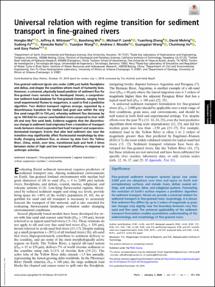| dc.contributor.author | Ma, Hongbo | |
| dc.contributor.author | Nittrouer, Jeffrey A. | |
| dc.contributor.author | Wu, Baosheng | |
| dc.contributor.author | Lamb, Michael P. | |
| dc.contributor.author | Zhang, Yuanfeng | |
| dc.contributor.author | Mohrig, David | |
| dc.contributor.author | Fu, Xudong | |
| dc.contributor.author | Naito, Kensuke | |
| dc.contributor.author | Wang, Yuanjian | |
| dc.contributor.author | Moodie, Andrew J. | |
| dc.contributor.author | Wang, Guangqian | |
| dc.contributor.author | Hu, Chunhong | |
| dc.contributor.author | Parker, Gary | |
| dc.date.accessioned | 2021-03-16T23:23:01Z | |
| dc.date.available | 2021-03-16T23:23:01Z | |
| dc.date.issued | 2019-12-18 | |
| dc.identifier.issn | 1091-6490 | es_PE |
| dc.identifier.uri | https://hdl.handle.net/20.500.12815/195 | |
| dc.description.abstract | Fine-grained sediment (grain size under 2,000 μm) builds floodplains and deltas, and shapes the coastlines where much of humanity lives. However, a universal, physically based predictor of sediment flux for fine-grained rivers remains to be developed. Herein, a comprehensive sediment load database for fine-grained channels, ranging from small experimental flumes to megarivers, is used to find a predictive algorithm. Two distinct transport regimes emerge, separated by a discontinuous transition for median bed grain size within the very fine sand range (81 to 154 μm), whereby sediment flux decreases by up to 100-fold for coarser sand-bedded rivers compared to river with silt and very fine sand beds. Evidence suggests that the discontinuous change in sediment load originates from a transition of transport mode between mixed suspended bed load transport and suspension-dominated transport. Events that alter bed sediment size near the transition may significantly affect fluviocoastal morphology by drastically changing sediment flux, as shown by data from the Yellow River, China, which, over time, transitioned back and forth 3 times between states of high and low transport efficiency in response to anthropic activities. | es_PE |
| dc.format | application/pdf | es_PE |
| dc.language.iso | eng | es_PE |
| dc.publisher | National Academy of Sciences | es_PE |
| dc.rights | info:eu-repo/semantics/openAccess | es_PE |
| dc.rights.uri | http://creativecommons.org/licenses/by-nc-nd/4.0/ | * |
| dc.source | Repositorio Institucional UTEC | es_PE |
| dc.source | Universidad de Ingeniería y Tecnología - UTEC | es_PE |
| dc.subject | Sediment transport | es_PE |
| dc.subject | Fine-grained environments | es_PE |
| dc.subject | Regime transition | es_PE |
| dc.subject | Critical suspension | es_PE |
| dc.subject | Number | es_PE |
| dc.subject | Universality | es_PE |
| dc.title | Universal relation with regime transition for sediment transport in fine-grained rivers | es_PE |
| dc.type | info:eu-repo/semantics/article | es_PE |
| dc.identifier.doi | https://doi.org/10.1073/pnas.1911225116 | es_PE |
| dc.identifier.journal | Proceedings of the National Academy of Sciences of the United States of America | es_PE |


